Chapter 01: �Introduction to Java
Lecturer: Mr. Sam Vanthath
- To understand the relationship between Java and World Wide Web.
- To know Java’s advantages.
- To distinguish the terms API, IDE and JDK.
- To write a simple Java program.
- To create, compile and run Java programs.
- To know the basic syntax of a Java program.
- To display output on the console and on the dialog box.
1. Java, World Wide Web, and Beyond
2. Characteristics of Java
3. The Java Language Specification, API, JDK, and IDE
4. A Simple Java Program
5. Creating, Compiling, and Executing a Java Program
6. Anatomy of the Java Program
- How to write Java application
- Input and Output statements
1. Java, World Wide Web, and Beyond (P. 13)
- Today Java is used for:
- Web Programming
- Developing standalone applications across platforms on
- and mobile devices
- Developing the code to communicate with and control the robotic rover that rolled on Mars.
2. Characteristics of Java (P. 16)
- Java particular feature is to write a program once and run it everywhere.
- Object-oriented
Distributed
Interpreted
- Architecture-neutral
- High-performance
Multithreaded
- Easier than C++
- Replace multiple inheritance in C++ with a simple language construct called an interface
- Eliminate pointers
- Use automatic memory allocation and garbage collection
- Easy to write and read
Object-Oriented
- Replace traditional procedure programming techniques.
- OOP models the real world in terms of objects.
- Central issue in software development is how to reuse code.
- OOP provides great flexibility, modularity, clarity and reusability through encapsulation, inheritance, and polymorphism.
- Several computers working together on a network.
- Java is designed to make distributed computing easy.
- Writing network programs in Java is like sending and receiving data to and from a file.
- Unlike conventional language translators
- Compiler converts source code into a machine-independent format (Byte code)
- allow it to run on any computer H/W that has the Java runtime system (Java Virtual Machine)
- Means reliable.
- Java has a runtime exception-handling feature.
- Java forces the programmer to write the code to deal with exceptions.
- Java can catch and respond to an exceptional situation
- so the program can continue its normal execution
- and terminate gracefully when a runtime error occurs.
- As an Internet programming language, Java is used in a networked and distributed environment.
- If you download a Java applet and run it on your computer, it will not damage your system.
Architecture-Neutral
- As Java is interpreted, this feature enables Java to be architecture-neutral or platform-independent.
- Using Java, developers need to write only one version of software so it can run on every platform (Windows, OS/2, Macintosh, and various UNIX, IBM AS/400, and IBM mainframes).
- Because Java is architecture-neutral, Java programs are portable.
- They can be run on any platform without being recompiled.
Performance
- Design well to perform on very low-power CPUs
- Easy to translate directly to native machine code
- Multithreading is a program’s capability to perform several tasks simultaneously (e.g: Downloading a video file while playing the video).
- Multithreading is particularly useful in GUI programming (e.g: a user can listen to an audio recording while surfing the Web page) and network programming (e.g: A server can serve multiple clients at the same time).
- Libraries can freely add new methods and instance variables.
- New class can be loaded on the fly without recompilation.
3. The Java Language Specification, API, JDK, and IDE (P. 19)
- Computer languages have strict rules of usages.
- If you do not follow the rules when writing a program, the computer will be unable to understand it.
- Java language specification and Java API define the Java standard.
Java Language specification & API
- Java Language specification is a technical definition of the language that includes the syntax and semantics of the Java programming language.
- The application programming interface (API) contains predefined classes and interfaces for developing Java programs.
- The Java language specification is stable, but the API is still expanding.
Java API Editions
- There are 3 editions of Java API: Java 2 Standard Edition (J2SE), Java 2 Enterprise Edition (J2EE) and Java 2 Micro Edition (J2ME).
- J2SE: used to develop client-side standalone applications or applets.
- J2EE: used to develop server-side applications, such as Java servlets and JavaServer Pages.
- J2ME: used to develop applications for mobile devices, such as cell phones.
Java Development Toolkit (JDK)
- For J2SE 5.0, the Java Development Toolkit is called JDK5.0, formerly known as JDK1.5.
- JDK consists of a set of separate programs for developing and testing Java programs, each of which is invoked from a command line.
- Besides JDK, there are more than a dozen Java development tools such as JBuilder, NetBeans, Sun ONE, Eclipse, JCreator, … These tools provide an integrated development environment (IDE) for rapidly developing Java programs (Editing, compiling, building, debugging and online help).
4. A Simple Java Program (P. 20)
- There are 2 Java Programs: Java Applications and applets.
- Java Applications can be executed from any computer with a Java interpreter.
- Java applets can be run directly from a Java-compatible Web browser. Applets are suitable for deploying Web projects.
A simple java applicationcode
// This application program prints Welcome to Java!
public class Welcome {
- public static void main(String[] args){
System.out.println( "Welcome to Java!" );
Class heading
Main method signature
5. Creating, Compiling, and Executing a Java Program (P. 21)
- You have to create your program and compile it before it can be executed.
- If your program has compilation errors, you have to fix them by modifying the program then recompile it.
- If your program has runtime errors or does not produce the correct result, you have to modify the program, recompile it and execute it again.
6. Anatomy of the Java Program (P. 23)
- The previous sample code has the following components:
- Reserved words
- The main method
- Comments help programmers and users to communicate and understand the program.
- Comments are ignored by the compiler.
- A line comment: //
- A paragraph comment: /*…*/
// This application prints Welcome!
/* This application prints Welcome!*/
/* This application prints
Reserved Words
- Reserved Words or Keywords are words that have a specific meaning to the compiler and cannot be used for other purpose in the program.
- E.g: class, public, static, void are keywords
- Java uses certain reserved words called modifiers that specify the properties of the data, methods and classes and how they can be used.
- E.g: public, static, private, final, abstract and protected
- A statement represents an action or a sequence of actions.
- The statement Systemout.println(“Welcome to Java!”) in previous code is a statement to display the greeting “Welcome to Java!”.
- Every statement in Java ends with a semicolon (;).
- The braces in the program form a block that groups the components of the program.
- A block begins with ({) and ends with (}).
- Every method has a method block that groups the statements in the method.
- Blocks can be nested.
public class Test{
System.out.println(“Welcome to java!”);
Class block
Method block
- The class is the essential Java construct.
- To program in Java, you must understand classes and be able to write and use them.
- A program is defined by using one or more classes.
- Method consists of a collection of statements that perform a sequence of operations.
- E.g: System.out.println?
- System.out: the standard output object
- println: the method in the object which to displays a message to the standard output device.
The main Method
- Every Java application must have a user-declared main method that defines where the program begins.
- The Java interpreter executes the application by invoking the main method.
- The main method looks like this:
- //Statemtns;
How to write Java applications
Two types of Java Program
- Applet Program
- Program which is running on Web Browser
- Use Appletviewer or internet explorer
- Application program
- Typical application program
- Execute using interpreter named “java”
Checkpoints for the Beginner
- Java differentiates the upper- and lower- cases.
- File differentiates the upper- and lower- cases.
- Should set the environment variables correctly.
- Run the program including main()
- The format of main is always� public static void main (String args[])
- Or public static void main (String[] args)
- Applet class is always public.
Checkpoints for the Beginner (Cont.)
- One file can have only one “public” class.�– compile error.
- If there is a class declared “public”, then the file name should be same as that public class name.
- Constructor doesn’t have a return type and has the same name as the class name.
- There is no comma between width and height in the HTML file.��<applet code=class-file-name width=300 height=200>�</applet>
Rules of naming the class and method
- English Noun type
- Starts with upper-case letter
- Coming multiple nouns : not with “_” , combine with another Uppercase.
- Ex. Car, ChattingServer
- Method Name
- English Verb type
- Starts with lower-case letter
- Ex. getName(), setLabel()
Input and Output Statements
Printing a Line of Text Example (Welcome1.java)
// Welcome1.java
// Text-printing program.
public class Welcome1 {
// main method begins execution of Java application
public static void main( String args[] )
System.out.println( “Welcome to Java Programming!” );
} // end method main
} // end class Welcome1
Printing a Line of Text (Cont.)
Compiling a program
- Open a command prompt window, go to directory where program is stored
- Type javac Welcome1.java
- If no errors, Welcome1.class created
- Has bytecodes that represent application
- Bytecodes passed to Java interpreter
- Executing a program
- Type java Welcome1
- Interpreter loads .class file for class Welcome1
- .class extension omitted from command
- Interpreter calls method main
Modifying Our First Java Program
- Modify example in Welcome1.java to print same contents using different code
- Modifying programs
- Welcome2.java produces same output as Welcome1.java
- Using different code�System.out.print( "Welcome to " ); System.out.println( "Java Programming!" );
- System.out.print( "Welcome to " ) displays “Welcome to ” with cursor remaining on printed line
- System.out.println( "Java Programming!" ) displays “Java Programming!” on same line with cursor on next line
Example (Welcome2.java)
// Welcome2.java
public class Welcome2 {
System.out.print( “Welcome to ” );
System.out.println( “Java Programming!” );
} // end class Welcome2
Modifying Our First Java Program (Cont.)
Newline characters (\n)
- Interpreted as “special characters” by methods System.out.print and System.out.println
- Indicates cursor should be on next line
- Welcome3.java�System.out.println( "Welcome\nto\nJava\nProgramming!" );
- Line breaks at \n
- Can use in System.out.println or System.out.print to create new lines
System.out.println( "Welcome\nto\nJava\nProgramming!" );
Example (Welcome3.java)
// Welcome3.java
public class Welcome3 {
} // end class Welcome3
- Escape characters
- Backslash ( \ ) indicates special characters to be output
| For example System.out.println( "\"in quotes\"" ); Displays "in quotes" |
Displaying Text in a Dialog Box
- Most Java applications use windows or a dialog box
- We have used command window
- Class JOptionPane allows us to use dialog boxes
- Set of predefined classes for us to use
- Groups of related classes called packages
- Group of all packages known as Java class library or Java applications programming interface (Java API)
- JOptionPane is in the javax.swing package
- Package has classes for using Graphical User Interfaces (GUIs)
Displaying Text in a Dialog Box (Cont.)
- Upcoming program
- Application that uses dialog boxes
- Explanation will come afterwards
- Demonstrate another way to display output
- Packages, methods and GUI
Example (Welcome4.java)
// Welcome4.java
// Printing multiple lines in a dialog box.
// Java packages
import javax.swing.JOptionPane; // program uses JOptionPane
public class Welcome4 {
JOptionPane.showMessageDialog(
null , "Welcome\nto\nJava\nProgramming!" );
System.exit( 0 );
// terminate application with window
} // end class Welcome4
Another Java Application : Adding Integers
- Use input dialogs to input two values from user
- Use message dialog to display sum of the two values
Example (Addition.java)
// Addition.java
// Addition program that displays the sum of two numbers.
public class Addition {
String firstNumber; // first string entered by user
String secondNumber; // second string entered by user
int number1; // first number to add
int number2; // second number to add
int sum; // sum of number1 and number2
// read in first number from user as a String
firstNumber = JOptionPane.showInputDialog( "Enter first integer" );
// read in second number from user as a String
secondNumber =
JOptionPane.showInputDialog( "Enter second integer" );
Example (Addition.java) (Cont.)
// convert numbers from type String to type int
number1 = Integer.parseInt( firstNumber );
number2 = Integer.parseInt( secondNumber );
// add numbers
sum = number1 + number2;
// display result
JOptionPane.showMessageDialog( null , "The sum is " + sum, "Results" ,� JOptionPane.PLAIN_MESSAGE );
System.exit( 0 ); // terminate application with window
} // end class Addition
| Icon |
Review Questions
- What is needed to run Java on a computer?
- What are the input and output of a Java compiler?
- Explain the Java keywords. List some that you have learned.
- Is Java case-sensitive? What is the case for Java keyword?
- What is the Java source filename extension, and what is the Java bytecode filename extension?
- What is the statement to display a string on the console? What is the statement to display the message “Hello World” in a message dialog box?
- Read Chapter01 Summary (P. 28-29)
- Create a Java program that displays these text in a dialog:
I am a student at CMU.
I am practicing Java code.
“Thanks!!!”
- Create a Java program that receives 3 input from users (Name, Midterm and Final score) and display the result on a dialog box:
Student Name: xxx xxx
Midterm score: xx pt
Final score: xx pt
Total score: xx pt


Java Tutorial
Control statements, java object class, java inheritance, java polymorphism, java abstraction, java encapsulation, java oops misc.
| Java is an object-oriented, class-based programming language. The language is designed to have as few dependencies implementations as possible. The intention of using this language is to give relief to the developers from writing codes for every platform. The term WORA, write once and run everywhere is often associated with this language. It means whenever we compile a Java code, we get the byte code (.class file), and that can be executed (without compiling it again) on different platforms provided they support Java. In the year 1995, Java language was developed. It is mainly used to develop web, desktop, and mobile devices. The Java language is known for its robustness, security, and simplicity features. That is designed to have as few implementation dependencies as possible. The Java language has a very interesting history. Patrick Naughton, Mike Sheridan, and Jame Gosling, known as the Green team, started the development of Java in the year 1991. These people were the engineers at . In 1996, the first public implementation was released as Java 1.0. The compiler of Java 1.0 was rewritten by Arthur Van Hoff to comply strictly with its specification. With the introduction of Java 2, the new versions have multiple different configurations that have been built for the various platforms. It is worth noting that James Gosling is also known as the father of Java. The ISO standard body was approached by Sun Microsystems in the year 1997 to formalize Java, but the process was withdrawn soon. At one point in time, Sun Microsystems provided most of its implementation of Java available without any cost, despite having the status of proprietary software. The Implementation of an application program in Java application includes the following steps. It is worth noting here that JDK (Java Development Kit) should be installed properly on the system, and the path should also be set. The Java program can be written using a Text Editor (Notepad++ or NotePad or other editors will also do the job.) or IDE (Eclipse, NetBeans, etc.). TestClass.java Write the above code and save the file with the name TestClass. The file should have the extension.
Open the command prompt, and type . is the command that makes the Java compiler come to action to compile the Java program. After the command, we must put the name of the file that needs to be compiled. In our case, it is . After typing, press the enter button. If everything goes well, a TestClass.class file will be generated that contains the byte code. If there is some error in the program, the compiler will point it out, and will not be created.
After the .class file is created, type to run the program. The output of the program will be shown on the console, which is mentioned below.
Initially, the name oak was given to the language. However, the team decided that a new name should be given to the language, and words like, DNA, revolutionary, Jolt, Dynamic, Silk, etc. were suggested. All these names were fun to say and easy to spell out. But what was missing was the essence of the language in the suggested names, which the team wanted to have. As per James Gosling, Java, and Silk were two of the most popular options, and since Java had a unique name, most people preferred it. Java is also a name of an island in Indonesia where coffee (named Java Coffee) was produced. The name Java was chosen by James Gosling because he was having coffee near his office. Readers should note that Java is not an acronym. It is just a name. JVM is the specification that facilitates the runtime environment in which the execution of the Java bytecode takes place. . JVM facilitates the definition of the memory area, register set, class file format, and fatal error reporting. Note that the JVM is platform dependent. It has already been discussed in the introductory part that the Java compiler compiles the Java code to generate the .class file or the byte code. One has to use the command to invoke the Java compiler. It is the complete Java Development Kit that encompasses everything, including JRE(Java Runtime Environment), compiler, java docs, debuggers, etc. JDK must be installed on the computer for the creation, compilation, and execution of a Java program. JRE is part of the JDK. If a system has only JRE installed, then the user can only run the program. In other words, only the command works. The compilation of a Java program will not be possible (the command will not work). Programmers are not able to delete objects in Java. In order to do so, JVM has a program known as Garbage Collector. Garbage Collectors recollect or delete unreferenced objects. Garbage Collector makes the life of a developer/ programmer easy as they do not have to worry about memory management. As the name suggests, classpath is the path where the Java compiler and the Java runtime search the .class file to load. Many inbuilt libraries are provided by the JDK. However, if someone wants to use the external libraries, it should be added to the classpath. Instead of directly generating the .exe file, Java compiler converts the Java code to byte code, and this byte code can be executed on different platforms without any issue, which makes Java a platform-independent language. Note that in order to execute the byte code, JVM has to be installed on the system, which is platform dependent. The concept of object-oriented programing is based on the concept of objects and classes. Also, there are several qualities that are present in object-oriented programming. A few of them are mentioned below. The Java language also extensively uses the concepts of classes and objects. Also, all these features mentioned above are there in Java, which makes Java an object-oriented programming language. Note that Java is an object-oriented programming language but not 100% object-oriented. Java is considered a simple language because it does not have the concept of pointers, multiple inheritances, explicit memory allocation, or operator overloading. Java language is very much robust. The meaning of robust is reliable. The Java language is developed in such a fashion that a lot of error checking is done as early as possible. It is because of this reason that this language can identify those errors that are difficult to identify in other programming languages. Exception Handling, garbage collections, and memory allocation are the features that make Java robust. There are several errors like buffer overflow or stack corruption that are not possible to exploit in the Java language. We know that the Java language does not have pointers. Therefore, it is not possible to have access to out-of-bound arrays. If someone tries to do so, ArrayIndexOutofBound Exception is raised. Also, the execution of the Java programs happens in an environment that is completely independent of the Operating System, which makes this language even more secure. Distributed applications can be created with the help of the Java language. Enterprise Java beans and Remote Method Invocation are used for creating distributed applications. The distribution of Java programs can happen easily between one or more systems that are connected to each other using the internet. The Java language supports multithreading. The multithreading feature supports the execution of two or more parts of the program concurrently. Thus, the utilization of the CPU is maximized. We know that Java is a platform-independent language. Thus, the byte code generated on one system can be taken on any other platform for execution, which makes Java portable. The architecture of Java is created in such a fashion that it decreases runtime overhead. In some places, Java uses JIT (Just In Time) compiler when the code is compiled on a demand basis, where the compiler is only compiling those methods that are invoked and thus making the faster execution of applications. The Java language follows the Object-Oriented programming paradigm, which gives us the liberty to add new methods and classes to the existing classes. The Java language also supports functions mentioned in C/C++ languages and which are generally referred to as the native methods. It is a known fact that Java programs are executed in different environment, which gives liberty to users to execute their own applications without impacting the underlying system using the bytecode verifier. The Bytecode verifier also gives extra security as it checks the code for the violation of access. The Java code is compiled by the compiler to get the .class file or the byte code, which is completely independent of any machine architecture. Most of languages are either interpreted language or the compiled language. However, in the case of the Java language, it is compiled as well as the interpreted language. The Java code is compiled to get the bytecode, and the bytecode is interpreted by the software-based interpreter.
DemoClass.java
AddMul.java
ComputeAv.java
FahrenheitCelsius.java
TriangleArea.java
It is used for putting comments in the code to make it more readable for the readers. The compiler ignores the comments completely while compiling the program. For multi lines comment, we use: /* … */ The most important method of the program where the execution begins. Therefore, all the logic must reside in the main method. If the main() method is not containing the logic, then it will be there in some other method, but that method must be invoked from the main() method directly or indirectly. The keyword class is used for declaring class in the Java language. it means that the function or method will not be returning anything. It is used to print statements, patterns, etc., on the console. It is a command line argument that is used for taking input. It is an access specifier keyword. When it is applied to a method, then that method is visible to all. Other access specifier keywords are, private, protected, and default. It means that all of the classes present in the package is imported. The java.io package facilitates the output and input streams for writing and reading data to files. * means all. If one wants to import only a specific class, then replace the * with the name of the class. It is the input stream that is utilized for reading characters from the input-giving device, which is usually a keyboard in our case. The static keyword tells that the method can be accessed without doing the instantiation of the class. As System.in is used for reading the characters, System.out is used to give the result of the program on an output device such as the computer screen. The different data types, int for the integers, double for double. Other data types are char, boolean, float, etc. The method shows the texts on the console. The method prints the text to the screen and then moves to the next line. For the next line, ln is used. If we do not want the cursor to move to the next line, use the method print(). |

- Send your Feedback to [email protected]
Help Others, Please Share

Learn Latest Tutorials
Transact-SQL
Reinforcement Learning
R Programming
React Native
Python Design Patterns
Python Pillow
Python Turtle
Preparation

Verbal Ability

Interview Questions

Company Questions
Trending Technologies
Artificial Intelligence
Cloud Computing
Data Science
Machine Learning
B.Tech / MCA
Data Structures
Operating System
Computer Network
Compiler Design
Computer Organization
Discrete Mathematics
Ethical Hacking
Computer Graphics
Software Engineering
Web Technology
Cyber Security
C Programming
Control System
Data Mining
Data Warehouse

Browse Course Material
Course info, instructors.
- Adam Marcus
Departments
- Electrical Engineering and Computer Science
As Taught In
- Programming Languages
- Software Design and Engineering
Learning Resource Types
Introduction to programming in java, lecture 1: types, variables, operators.
Lecture presentation on programming in Java. Topics include: the computer, CPU instructions, programming languages, Java, program structure, output, types, variables, and operators.

You are leaving MIT OpenCourseWare
Intro to Java
Get started with Java by learning about the basics of a Java program and variables!
- AI assistance for guided coding help
- Projects to apply new skills
- Quizzes to test your knowledge
- A certificate of completion
Skill level
Time to complete
Prerequisites
About this course
Ready to start your journey into the Java programming language? This course will walk you through understanding the program structure of a Java program, running your very first Java-based code, and storing data inside of a variable. Then you’ll start learning about object-oriented programming by exploring classes and methods.
Skills you'll gain
Write your first program
Assign variable values
Manipulate variables
Build a class from scratch
Hello World
Let’s start our journey with Java by writing and running our first program!
Learn how to create variables to allow your program to store data!
Object-Oriented Java
Learn about object-oriented programming in Java. Explore syntax for defining classes and creating instances.
Certificate of completion available with Plus or Pro
The platform
Hands-on learning

Projects in this course
Planting a tree, java variables: mad libs, earn a certificate of completion.
- Show proof Receive a certificate that demonstrates you've completed a course or path.
- Build a collection The more courses and paths you complete, the more certificates you collect.
- Share with your network Easily add certificates of completion to your LinkedIn profile to share your accomplishments.

Intro to Java course ratings and reviews
- 5 stars 71%
- 4 stars 21%
Our learners work at
- Google Logo
- Amazon Logo
- Microsoft Logo
- Reddit Logo
- Spotify Logo
- YouTube Logo
- Instagram Logo
Join over 50 million learners and start Intro to Java today!
Looking for something else, related resources, java program structure, java and the command line, java style guide, related courses and paths, study for the ap computer science a exam (java), learn java: object-oriented programming, browse more topics.
- Java 1,123,589 learners enrolled
- Code Foundations 7,053,688 learners enrolled
- Computer Science 5,500,773 learners enrolled
- Web Development 4,712,399 learners enrolled
- Data Science 4,232,082 learners enrolled
- Python 3,420,873 learners enrolled
- For Business 3,093,805 learners enrolled
- JavaScript 2,752,702 learners enrolled
- Data Analytics 2,234,521 learners enrolled

Unlock additional features with a paid plan
Practice projects, assessments, certificate of completion.
Got any suggestions?
We want to hear from you! Send us a message and help improve Slidesgo
Top searches
Trending searches

61 templates

el salvador
34 templates

17 templates

16 templates

49 templates

american history
85 templates
Java Programming Workshop
It seems that you like this template, java programming workshop presentation, free google slides theme, powerpoint template, and canva presentation template.
Programming... it's hard, it must be said! It won't be after you use this presentation! If you are an expert in Java and programming, share your knowledge in the form of a workshop. This template is designed for you to include everything you know about Java and show it to other interested people. The slides feature black backgrounds decorated with gradient lines of pink, blue, and purple — which by words can mean nothing, but if you look at it, it looks like any programming language! Don't wait any longer to download this template and prepare your workshop! People need your knowledge!
Features of this template
- 100% editable and easy to modify
- 32 different slides to impress your audience
- Contains easy-to-edit graphics such as graphs, maps, tables, timelines and mockups
- Includes 500+ icons and Flaticon’s extension for customizing your slides
- Designed to be used in Google Slides, Canva, and Microsoft PowerPoint
- 16:9 widescreen format suitable for all types of screens
- Includes information about fonts, colors, and credits of the resources used
How can I use the template?
Am I free to use the templates?
How to attribute?
Attribution required If you are a free user, you must attribute Slidesgo by keeping the slide where the credits appear. How to attribute?

Register for free and start downloading now
Related posts on our blog.

How to Add, Duplicate, Move, Delete or Hide Slides in Google Slides

How to Change Layouts in PowerPoint

How to Change the Slide Size in Google Slides
Related presentations.

Premium template
Unlock this template and gain unlimited access
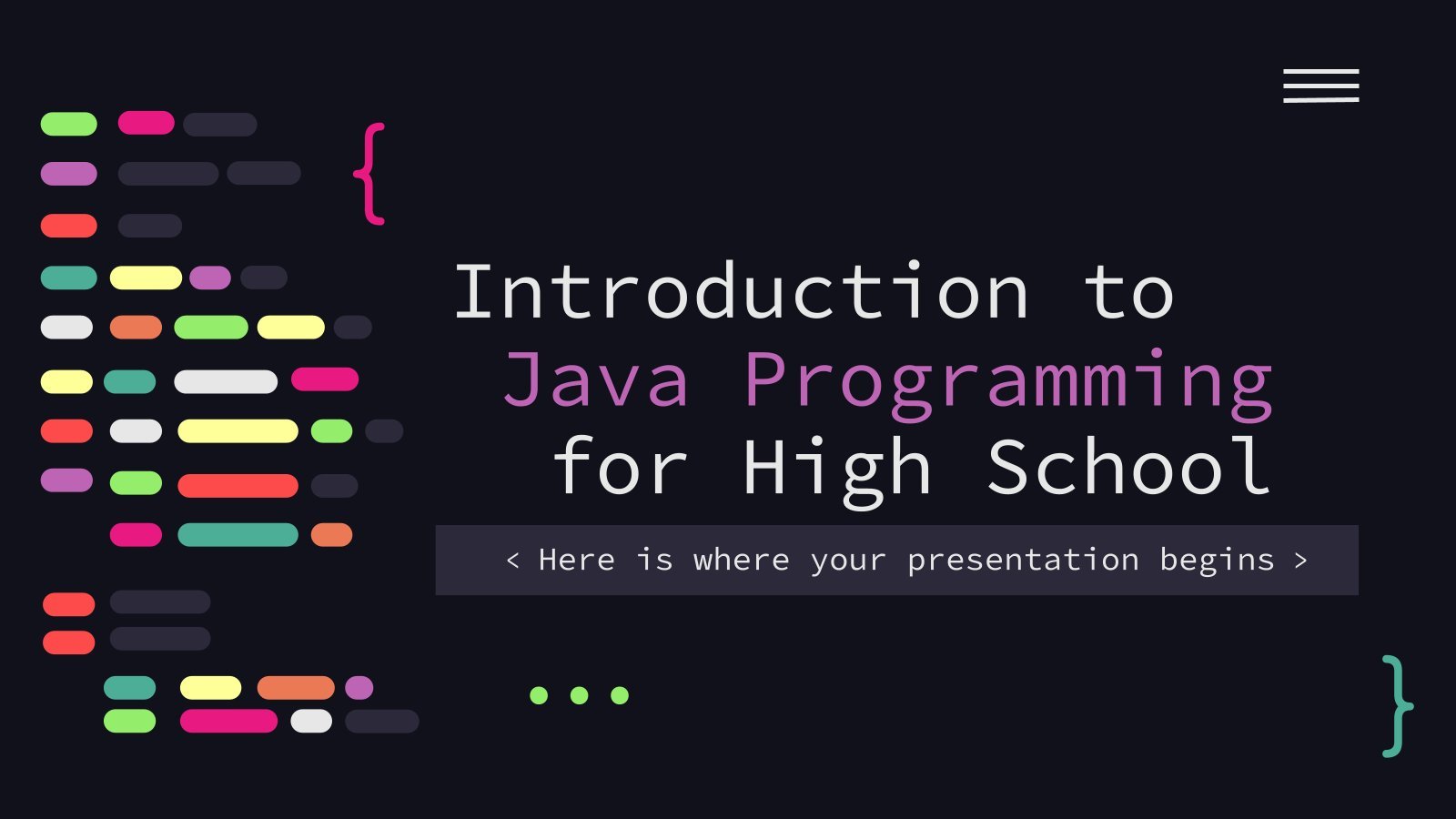

- My presentations
Auth with social network:
Download presentation
We think you have liked this presentation. If you wish to download it, please recommend it to your friends in any social system. Share buttons are a little bit lower. Thank you!
Presentation is loading. Please wait.
Introduction to Java Programming
Published by James Charles Modified over 6 years ago
Similar presentations
Presentation on theme: "Introduction to Java Programming"— Presentation transcript:
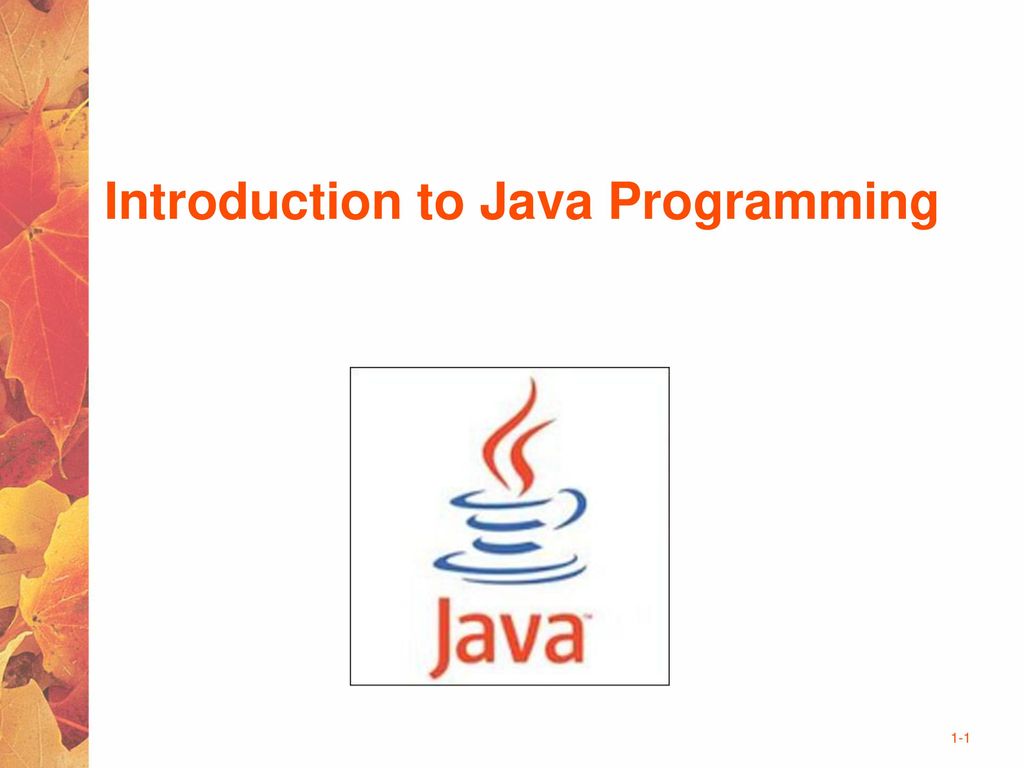
Chapter 1: Computer Systems

Programming with Java. Problem Solving The purpose of writing a program is to solve a problem The general steps in problem solving are: –Understand the.

1 Kursusform 13 uger med: Undervisning i klassen 1,5-2 timer Opgave ”regning” i databar (løsninger på hjemmeside) En midtvejsopgave der afleveres og.

The Java Programming Language

ECE122 L2: Program Development February 1, 2007 ECE 122 Engineering Problem Solving with Java Lecture 2 Program Development.

Aalborg Media Lab 21-Jun-15 Software Design Lecture 1 “ Introduction to Java and OOP”

Outline Java program structure Basic program elements

Chapter 1 Introduction. © 2004 Pearson Addison-Wesley. All rights reserved1-2 Outline Computer Processing Hardware Components Networks The Java Programming.

Chapter 1 Introduction.

1 Character Strings and Variables Character Strings Variables, Initialization, and Assignment Reading for this class: L&L,

Copyright © 2009 Pearson Education, Inc. Publishing as Pearson Addison-Wesley Java Software Solutions Foundations of Program Design Sixth Edition by Lewis.

© 2004 Pearson Addison-Wesley. All rights reserved1-1 Intermediate Java Programming Lory Al Moakar.

Prepared by Uzma Hashmi Instructor Information Uzma Hashmi Office: B# 7/ R# address: Group Addresses Post message:

HOW COMPUTERS MANIPULATE DATA Chapter 1 Coming up: Analog vs. Digital.

1 Variables, Constants, and Data Types Primitive Data Types Variables, Initialization, and Assignment Constants Characters Strings Reading for this class:

Outline Character Strings Variables and Assignment Primitive Data Types Expressions Data Conversion Interactive Programs Graphics Applets Drawing Shapes.

Copyright © 2011 Pearson Education, Inc. Publishing as Pearson Addison-Wesley John Lewis, Peter DePasquale, and Joseph Chase Chapter 1: Introduction.

CSC 1051 – Data Structures and Algorithms I Dr. Mary-Angela Papalaskari Department of Computing Sciences Villanova University Course website:

© 2006 Pearson Education Computer Systems Presentation slides for Java Software Solutions for AP* Computer Science A 2nd Edition.
About project
© 2024 SlidePlayer.com Inc. All rights reserved.
Navigation Menu
Search code, repositories, users, issues, pull requests..., provide feedback.
We read every piece of feedback, and take your input very seriously.
Saved searches
Use saved searches to filter your results more quickly.
To see all available qualifiers, see our documentation .
- Notifications You must be signed in to change notification settings
Spire.Presentation for Java is a professional PowerPoint API that enables developers to create, read, write, convert and save PowerPoint documents in Java Applications.
eiceblue/Spire.Presentation-for-Java
Folders and files.
| Name | Name | |||
|---|---|---|---|---|
| 22 Commits | ||||
Repository files navigation
Spire.presentation-for-java library for processing powerpoint documents.
Product Page | Tutorials | Examples | Forum | Customized Demo | Temporary License
Spire.Presentation for Java is a professional PowerPoint API that enables developers to create, read , write, convert and save PowerPoint documents in Java Applications. As an independent Java library, Spire.Presentation doesn't need Microsoft PowerPoint to be installed on system.
A rich set of features can be supported by Spire.Presentation for Java, such as add/edit/remove slide , create chart , create table , add bullets , encrypt and decrypt PPT , add watermark , add hyperlink , insert audio and video , paragraph settings, document properties settings , insert/extract image , extract text , set animation , add header and footer , add/delete comment, add note , create SmartArt .
Standalone Java API
Spire.Presentation for Java is a 100% independent Java PowerPoint API which doesn't require Microsoft PowerPoint to be installed on system.
Support PowerPoint Version
- PPT - PowerPoint Presentation 97-2003
- PPS - PowerPoint SlideShow 97-2003
- PPTX - PowerPoint Presentation 2007/2010/2013/2016/2019
- PPSX - PowerPoint SlideShow 2007, 2010
Rich PowerPoint Elements Supported
Spire.Presentation for Java supports to process a variety of PowerPoint elements, such as slide , text , image , shape , table , chart , watermark , animation , header and footer , comment , note , SmartArt , hyperlink , OLE object, audio and video .
High Quality PowerPoint File Conversion
Spire.Presentation for Java allow developers to convert PowerPoint documents to other file formats such as:
Convert PowerPoint to PDF
Convert PowerPoint to Image
Convert PowerPoint to SVG
Convert PowerPoint to XPS
Convert PowerPoint to HTML
Convert PowerPoint to PDF in Java
Convert powerpoint to images in java, convert powerpoint to svg in java.
Creating a MS PowerPoint Presentation in Java
Last updated: January 8, 2024
It's finally here:
>> The Road to Membership and Baeldung Pro .
Going into ads, no-ads reading , and bit about how Baeldung works if you're curious :)
Azure Container Apps is a fully managed serverless container service that enables you to build and deploy modern, cloud-native Java applications and microservices at scale. It offers a simplified developer experience while providing the flexibility and portability of containers.
Of course, Azure Container Apps has really solid support for our ecosystem, from a number of build options, managed Java components, native metrics, dynamic logger, and quite a bit more.
To learn more about Java features on Azure Container Apps, visit the documentation page .
You can also ask questions and leave feedback on the Azure Container Apps GitHub page .
Java applications have a notoriously slow startup and a long warmup time. The CRaC (Coordinated Restore at Checkpoint) project from OpenJDK can help improve these issues by creating a checkpoint with an application's peak performance and restoring an instance of the JVM to that point.
To take full advantage of this feature, BellSoft provides containers that are highly optimized for Java applications. These package Alpaquita Linux (a full-featured OS optimized for Java and cloud environment) and Liberica JDK (an open-source Java runtime based on OpenJDK).
These ready-to-use images allow us to easily integrate CRaC in a Spring Boot application:
Improve Java application performance with CRaC support
Modern software architecture is often broken. Slow delivery leads to missed opportunities, innovation is stalled due to architectural complexities, and engineering resources are exceedingly expensive.
Orkes is the leading workflow orchestration platform built to enable teams to transform the way they develop, connect, and deploy applications, microservices, AI agents, and more.
With Orkes Conductor managed through Orkes Cloud, developers can focus on building mission critical applications without worrying about infrastructure maintenance to meet goals and, simply put, taking new products live faster and reducing total cost of ownership.
Try a 14-Day Free Trial of Orkes Conductor today.
To learn more about Java features on Azure Container Apps, you can get started over on the documentation page .
And, you can also ask questions and leave feedback on the Azure Container Apps GitHub page .
Whether you're just starting out or have years of experience, Spring Boot is obviously a great choice for building a web application.
Jmix builds on this highly powerful and mature Boot stack, allowing devs to build and deliver full-stack web applications without having to code the frontend. Quite flexibly as well, from simple web GUI CRUD applications to complex enterprise solutions.
Concretely, The Jmix Platform includes a framework built on top of Spring Boot, JPA, and Vaadin , and comes with Jmix Studio, an IntelliJ IDEA plugin equipped with a suite of developer productivity tools.
The platform comes with interconnected out-of-the-box add-ons for report generation, BPM, maps, instant web app generation from a DB, and quite a bit more:
>> Become an efficient full-stack developer with Jmix
DbSchema is a super-flexible database designer, which can take you from designing the DB with your team all the way to safely deploying the schema .
The way it does all of that is by using a design model , a database-independent image of the schema, which can be shared in a team using GIT and compared or deployed on to any database.
And, of course, it can be heavily visual, allowing you to interact with the database using diagrams, visually compose queries, explore the data, generate random data, import data or build HTML5 database reports.
>> Take a look at DBSchema
Get non-trivial analysis (and trivial, too!) suggested right inside your IDE or Git platform so you can code smart, create more value, and stay confident when you push.
Get CodiumAI for free and become part of a community of over 280,000 developers who are already experiencing improved and quicker coding.
Write code that works the way you meant it to:
>> CodiumAI. Meaningful Code Tests for Busy Devs
The AI Assistant to boost Boost your productivity writing unit tests - Machinet AI .
AI is all the rage these days, but for very good reason. The highly practical coding companion, you'll get the power of AI-assisted coding and automated unit test generation . Machinet's Unit Test AI Agent utilizes your own project context to create meaningful unit tests that intelligently aligns with the behavior of the code. And, the AI Chat crafts code and fixes errors with ease, like a helpful sidekick.
Simplify Your Coding Journey with Machinet AI :
>> Install Machinet AI in your IntelliJ
Since its introduction in Java 8, the Stream API has become a staple of Java development. The basic operations like iterating, filtering, mapping sequences of elements are deceptively simple to use.
But these can also be overused and fall into some common pitfalls.
To get a better understanding on how Streams work and how to combine them with other language features, check out our guide to Java Streams:
Download the E-book
Do JSON right with Jackson
Get the most out of the Apache HTTP Client
Get Started with Apache Maven:
Working on getting your persistence layer right with Spring?
Explore the eBook
Building a REST API with Spring?
Get started with Spring and Spring Boot, through the Learn Spring course:
Explore Spring Boot 3 and Spring 6 in-depth through building a full REST API with the framework:
>> The New “REST With Spring Boot”
Get started with Spring and Spring Boot, through the reference Learn Spring course:
>> LEARN SPRING
Yes, Spring Security can be complex, from the more advanced functionality within the Core to the deep OAuth support in the framework.
I built the security material as two full courses - Core and OAuth , to get practical with these more complex scenarios. We explore when and how to use each feature and code through it on the backing project .
You can explore the course here:
>> Learn Spring Security
Spring Data JPA is a great way to handle the complexity of JPA with the powerful simplicity of Spring Boot .
Get started with Spring Data JPA through the guided reference course:
>> CHECK OUT THE COURSE

1. Introduction
In this article, we’ll see how we can create a presentation using Apache POI .
This library gives us a possibility to create PowerPoint presentations, read existing ones, and to alter their content.
2. Maven Dependencies
To begin, we’ll need to add the following dependencies into our pom.xml :
The latest version of both libraries can be downloaded from Maven Central.
3. Apache POI
The Apache POI library supports both .ppt and .pptx files , and it provides the HSLF implementation for the Powerpoint ’97(-2007) file format and the XSLF for the PowerPoint 2007 OOXML file format.
Since a common interface doesn’t exist for both implementations, we have to remember to use the XMLSlideShow , XSLFSlide and XSLFTextShape classes when working with the newer .pptx file format .
And, when it’s required to work with the older .ppt format, use the HSLFSlideShow , HSLFSlide and HSLFTextParagraph classes.
We’ll use the new .pptx file format in our examples, and the first thing we have to do is create a new presentation, add a slide to it (maybe using a predefined layout) and save it.
Once these operations are clear, we can then start working with images, text, and tables.
3.1. Create a New Presentation
Let’s first create the new presentation:
3.2. Add a New Slide
When adding a new slide to a presentation, we can also choose to create it from a predefined layout. To achieve this, we first have to retrieve the XSLFSlideMaster that holds layouts (the first one is the default master):
Now, we can retrieve the XSLFSlideLayout and use it when creating the new slide:
Let’s see how to fill placeholders inside a template:
Remember that each template has its placeholders, instances of the XSLFAutoShape subclass, which could differ in number from one template to another.
Let’s see how we can quickly retrieve all placeholders from a slide:
3.3. Saving a Presentation
Once we’ve created the slideshow, the next step is to save it:
4. Working With Objects
Now that we saw how to create a new presentation, add a slide to it (using or not a predefined template) and save it, we can start adding text, images, links, and tables.
Let’s start with the text.
When working with text inside a presentation, as in MS PowerPoint, we have to create the text box inside a slide, add a paragraph and then add the text to the paragraph:
When configuring the XSLFTextRun , it’s possible to customize its style by picking the font family and if the text should be in bold, italic or underlined.
4.2. Hyperlinks
When adding text to a presentation, sometimes it can be useful to add hyperlinks.
Once we have created the XSLFTextRun object, we can now add a link:
4.3. Images
We can add images, as well:
However, without a proper configuration, the image will be placed in the top left corner of the slide . To place it properly, we have to configure its anchor point:
The XSLFPictureShape accepts a Rectangle as an anchor point, which allows us to configure the x/y coordinates with the first two parameters, and the width/height of the image with the last two.
Text, inside of a presentation, is often represented in the form of a list, numbered or not.
Let’s now define a list of bullet points:
Similarly, we can define a numbered list:
In case we’re working with multiple lists, it’s always important to define the indentLevel to achieve a proper indentation of items.
4.5. Tables
Tables are another key object in a presentation and are helpful when we want to display data.
Let’s start by creating a table:
Now, we can add a header:
Once the header is completed, we can add rows and cells to our table to display data:
When working with tables, it’s important to remind that it’s possible to customize the border and the background of every single cell.
5. Altering a Presentation
Not always when working on a slideshow, we have to create a new one, but we have to alter an already existing one.
Let’s give a look to the one that we created in the previous section and then we can start altering it:
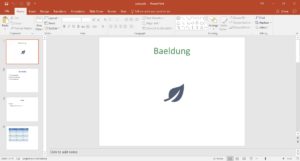
5.1. Reading a Presentation
Reading a presentation is pretty simple and can be done using the XMLSlideShow overloaded constructor that accepts a FileInputStream :
5.2. Changing Slide Order
When adding slides to our presentation, it’s a good idea to put them in the correct order to have a proper flow of slides.
When this doesn’t happen, it’s possible to re-arrange the order of the slides. Let’s see how we can move the fourth slide to be the second one:
5.3. Deleting a Slide
It’s also possible to delete a slide from a presentation.
Let’s see how we can delete the 4th slide:
6. Conclusion
This quick tutorial has illustrated how to use the Apache POI API to read and write PowerPoint file from a Java perspective.
The complete source code for this article can be found, as always, over on GitHub .
Looking for the ideal Linux distro for running modern Spring apps in the cloud?
Meet Alpaquita Linux : lightweight, secure, and powerful enough to handle heavy workloads.
This distro is specifically designed for running Java apps . It builds upon Alpine and features significant enhancements to excel in high-density container environments while meeting enterprise-grade security standards.
Specifically, the container image size is ~30% smaller than standard options, and it consumes up to 30% less RAM:
>> Try Alpaquita Containers now.
Explore the secure, reliable, and high-performance Test Execution Cloud built for scale. Right in your IDE:
Basically, write code that works the way you meant it to.
AI is all the rage these days, but for very good reason. The highly practical coding companion, you'll get the power of AI-assisted coding and automated unit test generation . Machinet's Unit Test AI Agent utilizes your own project context to create meaningful unit tests that intelligently aligns with the behavior of the code.
Get started with Spring Boot and with core Spring, through the Learn Spring course:

Follow the Java Category

- Spire.Office for .NET
- Spire.OfficeViewer for .NET
- Spire.Doc for .NET
- Spire.DocViewer for .NET
- Spire.XLS for .NET
- Spire.Spreadsheet for .NET
- Spire.Presentation for .NET
- Spire.PDF for .NET
- Spire.PDFViewer for .NET
- Spire.PDFViewer for ASP.NET
- Spire.DataExport for .NET
- Spire.Barcode for .NET
- Spire.Email for .NET
- Spire.OCR for .NET
- Free Spire.Office for .NET
- Free Spire.Doc for .NET
- Free Spire.DocViewer for .NET
- Free Spire.XLS for .NET
- Free Spire.Presentation for .NET
- Free Spire.PDF for .NET
- Free Spire.PDFViewer for .NET
- Free Spire.PDFConverter for .NET
- Free Spire.DataExport for .NET
- Free Spire.Barcode for .NET
- Spire.Office for WPF
- Spire.Doc for WPF
- Spire.DocViewer for WPF
- Spire.XLS for WPF
- Spire.PDF for WPF
- Spire.PDFViewer for WPF
- Order Online
- Download Centre
- Temporary License
- Purchase Policies
- Renewal Policies
- Find A Reseller
- Purchase FAQS
- Support FAQs
- How to Apply License
- License Agreement
- Privacy Policy
- Customized Demo
- Code Samples
- Unsubscribe
- API Reference
- Spire.Doc for Java
- Spire.XLS for Java
- Spire.Presentation for Java
- Spire.PDF for Java
- Become Our Reseller
- Paid Support
- Our Customers
- Login/Register

- Python APIs
- Android APIs
- AI Products
- .NET Libraries
- Free Products
- Free Spire.Email for .NET
- WPF Libraries
- Java Libraries
- Spire.Office for Java
- Spire.Barcode for Java
- Spire.OCR for Java
- Free Spire.Office for Java
- Free Spire.Doc for Java
- Free Spire.XLS for Java
Free Spire.Presentation for Java
- Free Spire.PDF for Java
- Free Spire.Barcode for Java
- C++ Libraries
- Spire.Office for C++
- Spire.Doc for C++
- Spire.XLS for C++
- Spire.PDF for C++
- Spire.Presentation for C++
- Spire.Barcode for C++
- Python Libraries
- Spire.Office for Python
- Spire.Doc for Python
- Spire.XLS for Python
- Spire.PDF for Python
- Spire.Presentation for Python
- Spire.Barcode for Python
- Android Libraries
- Spire.Office for Android via Java
- Spire.Doc for Android via Java
- Spire.XLS for Android via Java
- Spire.Presentation for Android via Java
- Spire.PDF for Android via Java
- Free Spire.Office for Android via Java
- Free Spire.Doc for Android via Java
- Free Spire.XLS for Android via Java
- Free Spire.Presentation for Android via Java
- Free Spire.PDF for Android via Java
- Cloud Libraries
- Spire.Cloud.Office
- Spire.Cloud.Word
- Spire.Cloud.Excel
- Swift Libraries
- Spire.XLS for Swift
- Spire.XLS AI for .NET
- Newsletter Subscribe Unsubscribe
- Spire.Presentation
- Spire.Barcode
- Spire.Email
- Spire.DocViewer
- Spire.PDFViewer
- Spire.SpreadSheet
- Spire.Cloud
- Spire.Doc for CPP
- Spire.XLS for CPP
- Spire.Presentation for CPP
- Spire.PDF for CPP
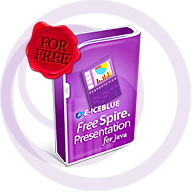
Free Java PowerPoint Library – Create Read Modify Print Convert PowerPoint Documents in Java
100%free java library to process powerpoint files.
| Spire.Presentation for Java is a professional PowerPoint API that enables developers to create, read, write, convert and save PowerPoint documents in Java Applications. As an independent Java library, Spire.Presentation doesn't need Microsoft PowerPoint to be installed on system. A rich set of features can be supported by Spire.Presentation for Java, such as , , , , PPT, , , insert and , , , , , , add header and , , , . Spire.Presentation for Java also supports to convert PowerPoint document to , , PPTX and in high quality. : | ||||
| Compared with the free version, the comemrcial editon has no slides limitation and is more comprehensive in processing PowerPoint files. | Free version is limited to 10 presentation slides when creating PPT and PPTX. When converting PowerPoint files to PDF, Image or XPS, you can only get the first 10 pages of the generated file. |

| Spire.Presentation for Java is a 100% Free and independent Java PowerPoint library, it doesn't require Microsoft Office or any other 3rd party library to be installed on system. | Spire.Presentation for Java allows converting PowerPoint to , , PPTX and file in high quality. | Spire.Presentation for Java supports to process a variety of PowerPoint elements, such as , , , , , , , , header and , , , , , OLE object, and . | |||||||||
| Spire.Presentation for Java can be easily integrated into Java applications. |

Convert PowerPoint to PDF
Converting PowerPoint to PDF helps you maintain the layout and formatting of your presentation when viewed on different systems or devices.

Convert PowerPoint to XPS
XPS is a fixed-layout document format similar to PDF. As such, when you need to print, transfer or archive a PowerPoint document, converting it to XPS format would also be a great option.

Convert PowerPoint to Image
Compared with PowerPoint presentations, images are easier to view and more user friendly, because they can be opened on almost any applications without the need for Microsoft PowerPoint.
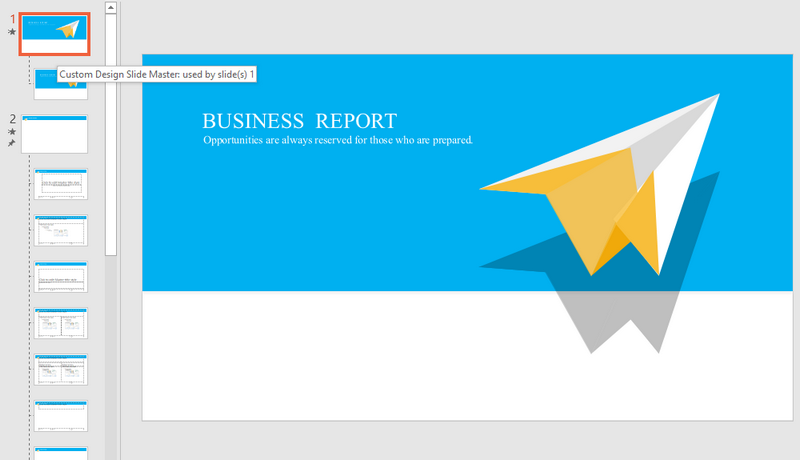
Create Slide Masters
A slide master controls the design of all the slides based on it. Using a slide master makes it easier to create presentations that look consistent and visually appealing.

Add a Watermark
Watermarks are used to declare confidentiality, copyright, source, or other attributes of the document, or as a decoration to make the document more attractive. Both text watermarks and image watermarks can be added to presentations.

Add Speaker Notes
Adding speaker notes to a PowerPoint presentation provides reference material for the speaker when they’re presenting a slideshow, allowing them to stay on track without forgetting the key points to deliver a flawless presentation.
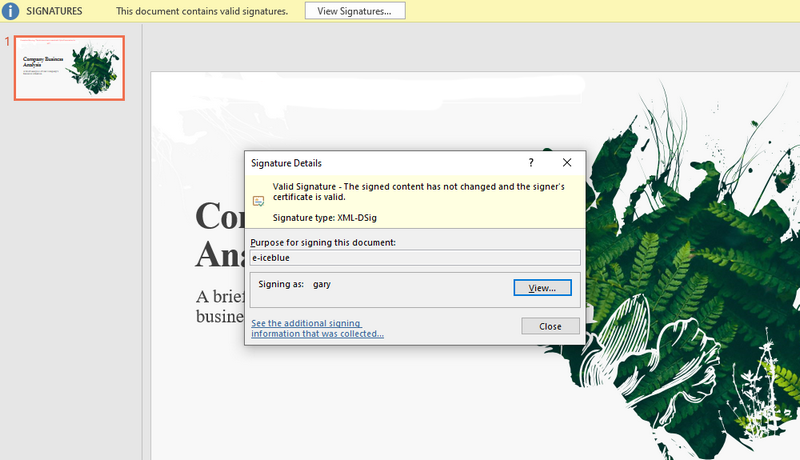
Digitally Sign PowerPoint Documents
A digital signature provides assurances about the validity and authenticity of your presentation. Once a PowerPoint document is digitally signed, any changes to the document will invalidate the signature.

Extract Text and Images
If you only need the text and images of a PowerPoint document regardless of their formatting and layout, you can directly extract them from the document.

Insert Charts
Charts in PowerPoint can help illustrate data, show trends or changes in data over time, and make the whole document more professional and attractive.
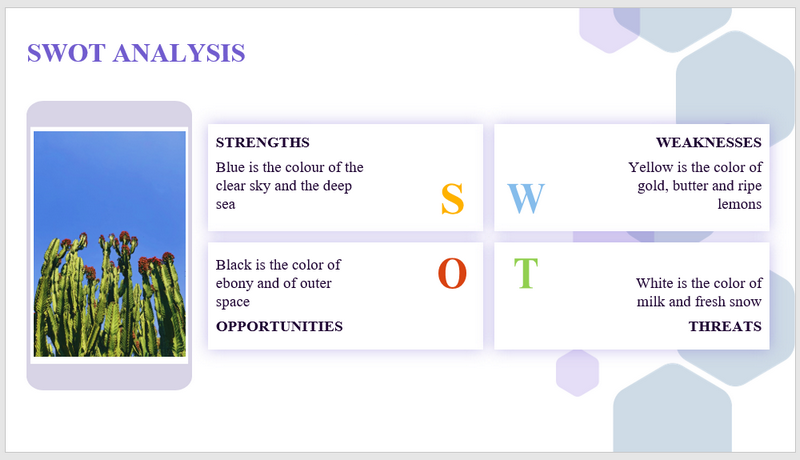
Insert Images and Shapes
Adding pictures and shapes can make your presentations more interesting and engaging. And you can customize your images by cropping, reordering, changing colors or adding other formatting and customize shape according to your own color palette, preferences.

Insert a SmartArt
SmartArt is a way to combine text, shapes and colors into an image or illustration. SmartArt graphics let you easily create a visual representation of your information.

100% Free Java Library to PowerPoint® Files

Free Spire.Presentation for Java is a professional PowerPoint API that enables developers to create, read, write, convert and save PowerPoint documents in Java Applications. As an independent Java library, Spire.Presentation doesn't need Microsoft PowerPoint to be installed on system.
A rich set of features can be supported by Free Spire.Presentation for Java, such as add/edit/remove slide , create chart , create table , add bullets , encrypt and decrypt PPT, add watermark , add hyperlink , insert audio and video , paragraph settings , document properties settings , insert/extract image , extract text , set animation , add header and footer , add/delete comment , add note , create SmartArt .
Free Spire.Presentation for Java also supports to convert PowerPoint document to image , PDF , PPTX and SVG in high quality.
Friendly Reminder : Free version is limited to 10 presentation slides. This limitation is enforced during writing PPT, PPTX. When converting PowerPoint files to PDF, Image, XPS, you can only get the first 3 pages of file. Upgrade to Commercial Edition of Spire.Presentation for Java . We don't provide technical or any other support to the users of the free versions.

Set Animations on Shapes in PowerPoint
Animation is a great way to emphasize important points, to control the flow of information, and to increase viewer interest in your presentation. You can animate almost every objects in PowerPoint slide to give them visual effects.
Standalone Java API
100% independent Java PowerPoint API which doesn't require Microsoft PowerPoint to be installed on system.
- PPT - PowerPoint Presentation 97-2003
- PPS - PowerPoint SlideShow 97-2003
- PPTX - PowerPoint Presentation 2007/2010/2013/2016/2019
- PPSX - PowerPoint SlideShow 2007, 2010
Powerful Toolset, Multichannel Support

Work with PowerPoint Charts

Print PowerPoint Presentations

Work with SmartArt

Images and Shapes

Audio and Video

Protect Presentation Slides

Text and Image Watermark

Merge Split PowerPoint Document

Comments and Notes

Manage PowerPoint Tables

Set Animations on Shapes

Manage Hyperlink

Extract Text and Image

Replace Text
Conversion File Documents with High Quality

PowerPoint Document

MAIN FUNCTION
Only Free Spire.Presentation for Java, No Microsoft Office Installed
High Quality PowerPoint File Conversion
Rich PowerPoint Elements Supported
Easy Integration
Commercial Edition $799
Compared with the free version, the comemrcial editon has no slides limitation and is more comprehensive in processing PowerPoint files.
Free Edition $0
Free version is limited to 10 presentation slides when creating PPT and PPTX. When converting PowerPoint files to PDF, Image or XPS, you can only get the first 10 pages of the generated file.
GET STARTED
Free Trials for All Progress Solutions
Support Environment
Support powerpoint version, paragraph and text, image and shape, table and chart, comment and note.
Here is a brief summary of Free Spire.Presentation for Java features.
- 100% Written in Java
- Supports 32-bit and 64-bit OS
- Works on Windows, Linux, Unix and Mac OS
- No Need to Install Additional Software
- PPTX - PowerPoint Presentation 2007, 2010, 2013, 2016 and 2019
- Convert PPT/PPTX to Image
- Convert PPT/PPTX to PDF
- Convert PPT to PPTX
- Convert PPT/PPTX to SVG
- Convert PPT/PPTX to HTML
- Convert PPT/PPTX to XPS
- Encrypt Documents
- Remove Encryption
- Set Document to Read Only
- Create, Remove, Hide and Clone Slide
- Change Slide Layout
- Add Master Slide
- Set Background
- Set Transitions
- Set Paragraph Indent
- Add Bullets
- Extract Text
- Insert Hyperlinks
- Add Text Watermark
- Insert Image
- Insert Shape
- Fill Shape (with solid, gradient color or picture)
- Extract Image and Shape
- Set Animations
- Create Table
- Create Combination Chart
- Create Doughnut Chart
- Save Chart as Image
- Merge Table Cell
- Insert Audio
- Insert Video
- Insert SmartArt
- Add and Remove Node
- Add comment
- Delete comment
| We guarantee one business day Forum questions Reply. | We guarantee one business day E-mail response. | Free Customized service for OEM Users. | |||||||||||
| Skype name: iceblue.support | Apply for a Free Trial License File. | ||||||||||||
- Believe The Users
- Spire.Spreadsheet
- Purchase FAQs
- License Upgrade
- Our Service

DEV Community
Posted on Dec 14, 2018 • Updated on Dec 17, 2018
Create PowerPoint Presentations in Java
In this article, we will show you how to create PowerPoint presentations from scratch using a free Java PowerPoint API – Free Spire.Presentation for Java.
Table of Contents
Overview of free spire.presentation for java, create a “hello world” presentation.
- Format Content in Presentation
Add Images to Presentation
Add bullet list to presentation, create table in presentation, create chart in presentation, set document properties to presentation, protect presentation with password.
Free Spire.Presentation for Java is a free Java PowerPoint API, by which developers can create, read, modify, write, convert and save PowerPoint document in Java applications without installing Microsoft Office.
For more information of Free Spire.Presentation for Java, check here .
Download Free Spire.Presentation jars: https://www.e-iceblue.com/Download/presentation-for-java-free.html
The following example shows how to create a simple presentation with “Hello World” text.
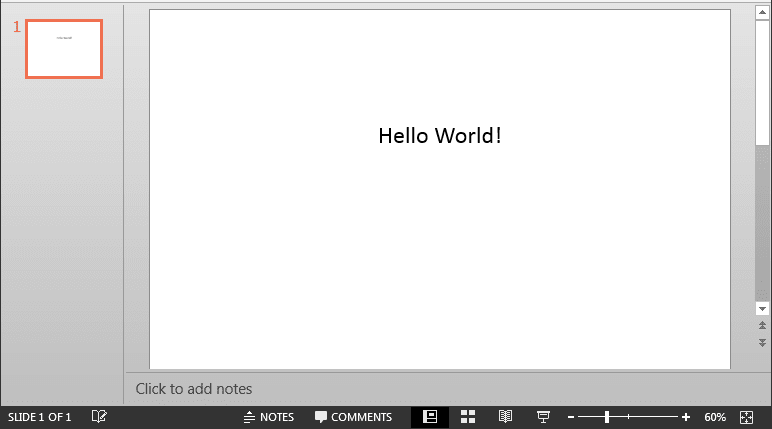
Format Text Content in Presentation
The following example shows how to format text content in a presentation.
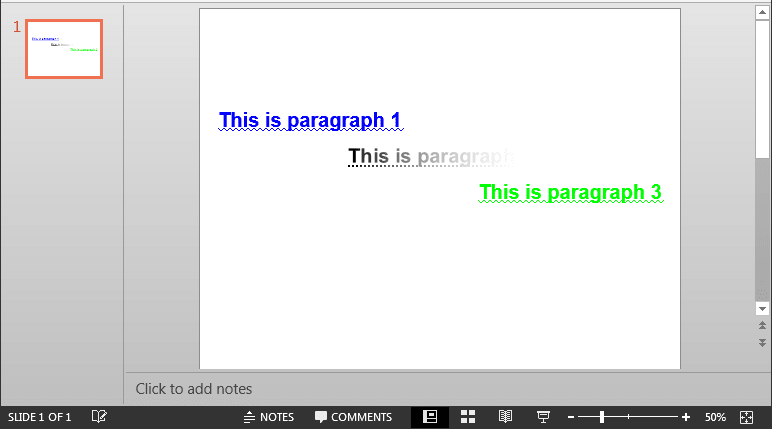
The following example shows how to add images to a presentation.
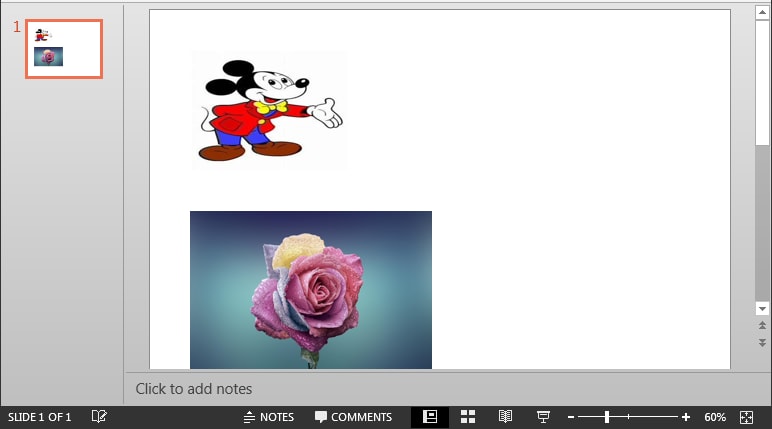
The following example shows how to add bullet list to presentation.
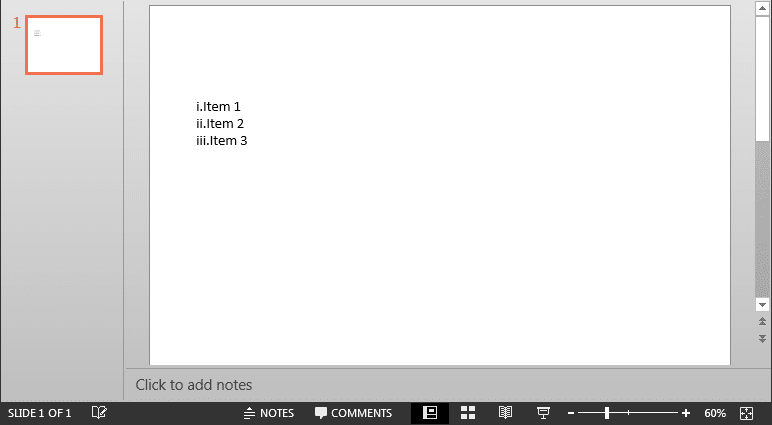
The following example shows how to create table in presentation.
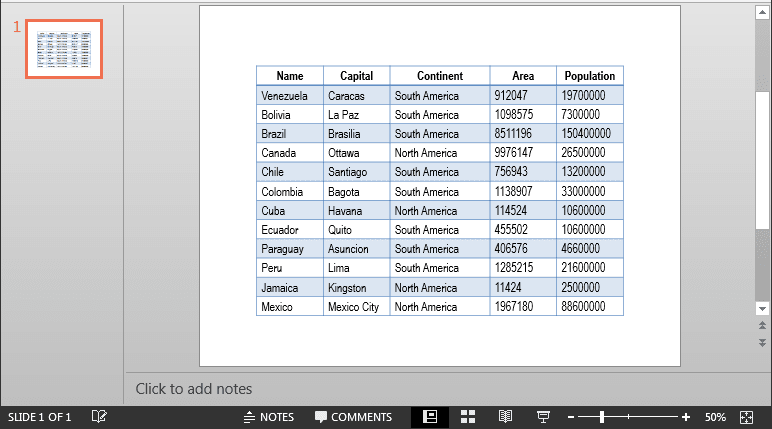
Free Spire.Presentation for Java supports a variety types of charts. Here we choose bubble chart as an example.

The following example shows how to set document properties, such as author, company, key words, comments, category, title and subject, to a presentation.
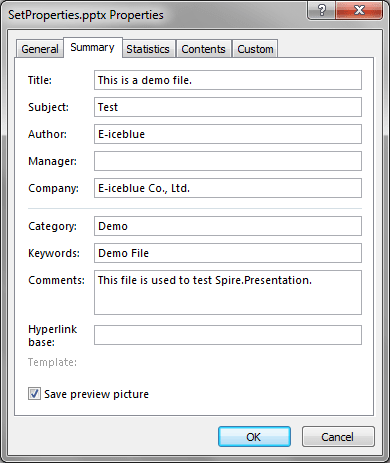
The following example shows how to protect a presentation with password.
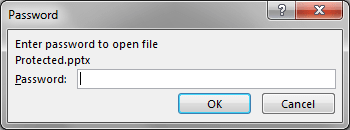
Top comments (0)
Templates let you quickly answer FAQs or store snippets for re-use.
Are you sure you want to hide this comment? It will become hidden in your post, but will still be visible via the comment's permalink .
Hide child comments as well
For further actions, you may consider blocking this person and/or reporting abuse

Advantages of Using HTTP Interface in Spring 6
Guilherme Siqueira - Aug 6

Case Study: Computing Fibonacci Numbers
Paul Ngugi - Jul 2

Multithreading and Patterns
lucasnscr - Aug 5

Configurando o Spring com JPA e Microsoft SQL Server
Kaique de Miranda - Jul 2

We're a place where coders share, stay up-to-date and grow their careers.
- Java Course
- Java Arrays
- Java Strings
- Java Collection
- Java 8 Tutorial
- Java Multithreading
- Java Exception Handling
- Java Programs
- Java Project
- Java Collections Interview
- Java Interview Questions
- Spring Boot
How to Create a MS PowerPoint Presentation in Java with a Maven Project?
In the software industry, presentations play a major role as information can be conveyed easily in a presentable way via presentations. Using Java, with the help of Apache POI, we can create elegant presentations. Let us see in this article how to do that.
Necessary dependencies for using Apache POI:
It has support for both .ppt and .pptx files. i.e. via
- HSLF implementation is used for the Powerpoint 97(-2007) file format
- XSLF implementation for the PowerPoint 2007 OOXML file format.
There is no common interface available for both implementations. Hence for
- .pptx formats, XMLSlideShow, XSLFSlide, and XSLFTextShape classes need to be used.
- .ppt formats, HSLFSlideShow, HSLFSlide, and HSLFTextParagraph classes need to be used.
Let us see the example of creating with .pptx format
Creation of a new presentation:
Next is adding a slide
Now, we can retrieve the XSLFSlideLayout and it has to be used while creating the new slide
Let us cover the whole concept by going through a sample maven project.
Example Maven Project
Project Structure:
As this is the maven project, let us see the necessary dependencies via pom.xml
| " " "> |
PowerPointHelper.java
In this file below operations are seen
- A new presentation is created
- New slides are added
- save the presentation as
We can write Text, create hyperlinks, and add images. And also the creation of a list, and table are all possible. In general, we can create a full-fledged presentation easily as well can alter the presentation by adjusting the slides, deleting the slides, etc. Below code is self-explanatory and also added comments to get an understanding of it also.
| " |
We can able to get the presentation got created according to the code written and its contents are shown in the image below
We can test the same by means of the below test file as well
PowerPointIntegrationTest.java
Output of JUnit:
We have seen the ways of creating of presentation, adding text, images, lists, etc to the presentation as well as altering the presentation as well. Apache POI API is a very useful and essential API that has to be used in software industries for working with the presentation.

Please Login to comment...
Similar reads.
- Technical Scripter
- Technical Scripter 2022
- How to Get a Free SSL Certificate
- Best SSL Certificates Provider in India
- Elon Musk's xAI releases Grok-2 AI assistant
- What is OpenAI SearchGPT? How it works and How to Get it?
- Content Improvement League 2024: From Good To A Great Article
Improve your Coding Skills with Practice
What kind of Experience do you want to share?

IMAGES
COMMENTS
Chapter 01: Introduction to Java. To understand the relationship between Java and World Wide Web. To know Java's advantages. To distinguish the terms API, IDE and JDK. To write a simple Java program. To create, compile and run Java programs. To know the basic syntax of a Java program.
Lecture presentation on programming in Java. Topics include: object oriented programming, defining classes, using classes, constructors, methods, accessing fields, primitives versus references, references versus values, and static types and methods.
Introduction To Java. Java is an object-oriented, class-based programming language. The language is designed to have as few dependencies implementations as possible. The intention of using this language is to give relief to the developers from writing codes for every platform. The term WORA, write once and run everywhere is often associated ...
Lecture presentation on programming in Java. Topics include: the computer, CPU instructions, programming languages, Java, program structure, output, types, variables ...
Ready to start your journey into the Java programming language? This course will walk you through understanding the program structure of a Java program, running your very first Java-based code, and storing data inside of a variable. Then you'll start learning about object-oriented programming by exploring classes and methods.
Activity : Create and Execute a Java project Writing a simple HelloWorld program in Java using Eclipse. Step l: Start Eclipse. Step 2: Create a new workspace called sample and 01. Project Eun Step 5: Select "Java" in the categ Java EE - Eclipse Eile Edit Navigate Search ti ct • Select "Java Project" in the project list.
It won't be after you use this presentation! If you are an expert in Java and programming, share your knowledge in the form of a workshop. This template is designed for you to include everything you know about Java and show it to other interested people. The slides feature black backgrounds decorated with gradient lines of pink, blue, and ...
CORE JAVA Fundamentals of OOP What is OOP Difference between Procedural and Object oriented programming Basic OOP concept - Object, classes, abstraction,encapsulation, inheritance, polymorphism 1 Fundamentals of OOP Introduction to JAVA Introductin to JAVA 2 History of Java Java ... Creating engaging teacher presentations: tips, ideas, and ...
Java is high-level programming language originally developed by Sun Microsystems and released in 1995. Java runs on a variety of platforms, such as Windows, Mac OS/ and the various versions of UNIX. According to SUN, 3 billi n devices run java. There are many devices where java is currently used. Some of them are as follows: Presentation by Abk ...
Free Google Slides theme, PowerPoint template, and Canva presentation template. Hey teachers, get your students coding in no time with our sleek, minimal black PowerPoint and Google Slides template tailored for high school Java programming lessons. This easy-to-use, engaging slideshow template is perfect for breaking down the basics of Java ...
Download ppt "Introduction to Java Programming". Focus of the Course Object-Oriented Software Development problem solving program design, implementation, and testing object-oriented concepts classes objects encapsulation inheritance polymorphism.
Java And J2EE (160 Slides) 6210 Views. Unlock a Vast Repository of Java And J2EE PPT Slides, Meticulously Curated by Our Expert Tutors and Institutes. Download Free and Enhance Your Learning!
Spire.Presentation for Java is a professional PowerPoint API that enables developers to create, read, write, convert and save PowerPoint documents in Java Applications. As an independent Java library, Spire.Presentation doesn't need Microsoft PowerPoint to be installed on system.
Java applications have a notoriously slow startup and a long warmup time. The CRaC (Coordinated Restore at Checkpoint) project from OpenJDK can help improve these issues by creating a checkpoint with an application's peak performance and restoring an instance of the JVM to that point.. To take full advantage of this feature, BellSoft provides containers that are highly optimized for Java ...
DOWNLOAD. Free Spire.Presentation for Java is a professional PowerPoint API that enables developers to create, read, write, convert and save PowerPoint documents in Java Applications. As an independent Java library, Spire.Presentation doesn't need Microsoft PowerPoint to be installed on system. A rich set of features can be supported by Free ...
Free Spire.Presentation for Java is a free Java PowerPoint API, by which developers can create, read, modify, write, convert and save PowerPoint document in Java applications without installing Microsoft Office. For more information of Free Spire.Presentation for Java, check here.
A new presentation is created. New slides are added. save the presentation as. FileOutputStream outputStream = new FileOutputStream(fileLocation); samplePPT.write(outputStream); outputStream.close(); We can write Text, create hyperlinks, and add images. And also the creation of a list, and table are all possible.